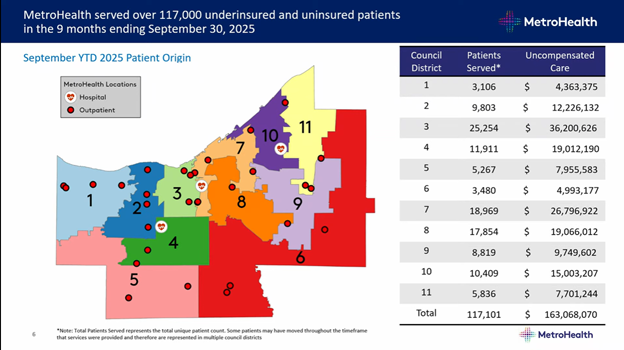Just two weeks after the first department hearing for the Cuyahoga County Department of Health and Human Services, the final—and arguably one of the highest profile—pieces of the county’s safety net had its budget hearing in front of County Council. President and CEO of The MetroHealth System, Dr. Christine Alexander-Rager, presented on MetroHealth’s budget and answered questions from Councilmembers.
Growth, optimism, and increasing costs
Dr. Alexander-Rager began her presentation by highlighting the growth that the system has seen during 2025, which includes emergency department visits, prescriptions filled, surgical cases, and operating revenue. She noted that while there is optimism surrounding the much of this growth, costs have also grown. Noting that 2025 expenses for medical supplies are up 14.9% a $20.0 million increase, pharmaceuticals are up 17.1% a $50.9 million increase, and charity care is up 33.0% a $91.2 million increase compared to 2024.
Charity Care includes care that is provided to patients who are uninsured while Uncompensated Care also includes the underinsured.
Charity Care, in addition to Uncompensated Care, are imperative aspects of MetroHealth, as it is the county’s safety net hospital. As explained by Dr. Alexander-Rager, Charity Care includes care that is provided to patients who are uninsured while Uncompensated Care also includes the underinsured.
Underinsured patients are patients who have health insurance plans but is insufficient. The insufficiency could be related to coverage, or it could be related to unaffordability of the plan’s deductible. The image below, displayed during the hearing, illustrates the number of patients serves and the cost of the uncompensated care by Council District through September 2025.

Offsetting budget instability with reductions, restrictions, and executive pay cuts
While Charity and Uncompensated Care are a large driving force to the budgetary instability that The MetroHealth System has faced recently, it has worked to curtail expenses elsewhere. This includes implementing a hiring freeze and travel restrictions, pay cuts for executives, reductions in force, and site closures. Dr. Alexander-Rager mentioned many times during her presentation that the organization is examining every way possible to ensure the fiscal health of the system.
When discussing the budget, Dr. Alexander-Rager presented the budget as a whole and did not just speak about the subsidy received by the County through the Health and Human Service Levy Fund. MetroHealth is expecting an operating budget shortfall of $48.3 million in the current year and is projecting that shortfall is be $31.2 million in 2026, which is an improvement of $17.2 million.
While it would not balance MetroHealth’s budget in 2026 it is worth noting that the County Executive’s recommended budget decreases the subsidy received by the health system from $35.0 million in 2025 to $32.0 million in 2026 and then increases it to $33.5 million in 2027.
In closing, MetroHealth’s President include three asks of County Council in her presentation they are:
- No reduction to MetroHealth’s HHS levy support
- County Council’s help in spreading the word about MetroHealth’s health and enrollment events
- Council Council’s time by attending and/or volunteering at different MetroHealth events
Insight into possible budget changes
Councilman Gallagher mentioned that he has spoken to a couple of fellow councilmembers and plans to speak to all members about his budget amendment, which would provide a total of $36 million to MetroHealth in 2026 and 2027 from a non-Health and Human Services Levy Fund source.
Looking ahead
Cuyahoga County’s safety net is done testifying in front of County Council. The Department of Health and Human Services finished its budget hearings early this month, and with The MetroHealth System completing its hearing, things will be quiet on this front until budget amendments are released. The Center for Community Solutions will continue to report on the health and human service provisions of the budget and advocate for a strong safety net for Cuyahoga County’s residents.








